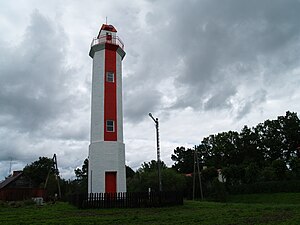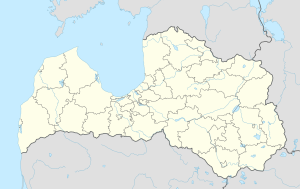This article includes a list of general references, but it lacks sufficient corresponding inline citations. (May 2022) |
Ainaži[a][b] (Estonian: Heinaste; Livonian: Āinast) is a Latvian port town by the Gulf of Riga in the Baltic Sea. Administratively, it is part of the Limbaži Municipality in the Vidzeme region of Latvia. It is located on the south side of the Estonia-Latvia international border, on the site of an ancient Livonian fishing village.
Ainaži
Heinaste (Estonian) | |
|---|---|
Town | |
 Ainaži lighthouse | |
| Coordinates: 57°51′49″N 24°21′31″E / 57.86361°N 24.35861°E | |
| Country | |
| Municipality | Limbaži Municipality |
| Area | |
• Total | 5.12 km2 (1.98 sq mi) |
| • Land | 4.91 km2 (1.90 sq mi) |
| • Water | 0.21 km2 (0.08 sq mi) |
| Elevation | 0 m (0 ft) |
| Population (2024)[2] | |
• Total | 644 |
| • Density | 130/km2 (330/sq mi) |
| Time zone | UTC+2 (EET) |
| • Summer (DST) | UTC+3 (EEST) |
| Postal code | LV-4035 |
| Calling code | 640 |
| Climate | Dfb |
| Website | [1] |
Etymology
editThe name Ainaži may be derived from the Estonian language word heina(s)-tee 'hay-road'. Other possibilities include the Livonian words āina 'hay' or āinagi 'lonely, only'. Historically, the German language variants of the same name (e.g., Haynasch), were used in most written records from the late Middle Ages until the first half of the 20th century.
History
editAinaži existed for centuries as a Livonian fishing village. The town itself was first mentioned in 1564, and through the ages, changed hands among various barons and estates. Ainaži entered a great period of growth in the 1870s when its history of shipbuilding and seafaring began.
In the 19th century, Vidzeme and Courland were covered with vast forests of pine trees. Ainaži's strategic position on the sea and proximity to lumber made it a perfect place for shipbuilding. In 1864, Krišjānis Valdemārs sponsored the first naval school in Livonia (today Latvia), training young Estonian and Latvian farmers to become ship captains for free. The school stood for 50 years until it was destroyed in World War I. With the opening of the school and shipbuilding industry, Ainaži grew for the rest of the 19th century. From 1857 to 1913, over 50 seaworthy vessels were built in the town, and in 1902 a working port and railway station opened. By World War I, Ainaži was the fourth-largest port in all of Latvia and chief in Vidzeme, overtaking neighboring Salacgrīva. The town also had its own windmills, fish-processing plant, and brick kiln.
In World War I Ainaži was heavily damaged. The port was ruined and the entire shipping fleet destroyed. In February 1919, the Estonian army drove the Germans from Ainaži and subsequently occupied it. After the war, Ainaži became part of Latvia after its inhabitants voted for Latvia in a referendum,[3] but Estonia's troops remained stationed there until 1920 and Estonia kept the northern section of the town, the Ikla village.
In the years of independent Republic of Latvia (1918–1940) Ainaži was revitalized. The Ainaži fleet, sunken in the war, had completely barricaded the harbor and had to be removed. The harbor was then deepened, and the port was rebuilt in 1923 with new breakers. In 1930 the Ainaži lighthouse was built.
In World War II, however, Ainaži was destroyed again. The second naval academy burned down, the port was bombed, and the warehouses were plundered. Though the port was partially rebuilt after the war, Ainaži was overshadowed by nearby Pärnu, and lost its fish-processing factory to Salacgrīva.
After Latvia's independence was restored in 1991, a wind turbine was built in Ainaži, as well as a customs house on the Estonian border. Today, the building of the naval school hosts the Museum of Ainaži Naval School (Ainažu jūrskolas muzejs), dedicated to the history of the school and the tradition of shipbuilding along the Vidzeme coast.
Climate
editAinaži has a humid continental climate (Köppen Dfb).
| Climate data for Ainaži (1991-2020 normals, extremes 1906–present) | |||||||||||||
|---|---|---|---|---|---|---|---|---|---|---|---|---|---|
| Month | Jan | Feb | Mar | Apr | May | Jun | Jul | Aug | Sep | Oct | Nov | Dec | Year |
| Record high °C (°F) | 8.1 (46.6) |
10.8 (51.4) |
18.3 (64.9) |
25.3 (77.5) |
29.8 (85.6) |
33.2 (91.8) |
33.7 (92.7) |
33.2 (91.8) |
30.0 (86.0) |
22.0 (71.6) |
15.4 (59.7) |
10.5 (50.9) |
33.7 (92.7) |
| Mean daily maximum °C (°F) | −0.4 (31.3) |
−0.7 (30.7) |
2.9 (37.2) |
9.6 (49.3) |
15.3 (59.5) |
18.9 (66.0) |
21.9 (71.4) |
21.2 (70.2) |
16.5 (61.7) |
10.1 (50.2) |
4.7 (40.5) |
1.6 (34.9) |
10.1 (50.2) |
| Daily mean °C (°F) | −2.6 (27.3) |
−3.3 (26.1) |
−0.3 (31.5) |
5.2 (41.4) |
10.6 (51.1) |
14.8 (58.6) |
17.7 (63.9) |
17.0 (62.6) |
12.6 (54.7) |
7.1 (44.8) |
2.6 (36.7) |
−0.4 (31.3) |
6.7 (44.2) |
| Mean daily minimum °C (°F) | −5.4 (22.3) |
−6.5 (20.3) |
−4.0 (24.8) |
0.6 (33.1) |
4.9 (40.8) |
9.6 (49.3) |
12.5 (54.5) |
11.9 (53.4) |
8.2 (46.8) |
3.8 (38.8) |
0.0 (32.0) |
−2.9 (26.8) |
2.7 (36.9) |
| Record low °C (°F) | −35.7 (−32.3) |
−35.3 (−31.5) |
−34.4 (−29.9) |
−18.8 (−1.8) |
−7.5 (18.5) |
−1.3 (29.7) |
2.0 (35.6) |
0.2 (32.4) |
−4.8 (23.4) |
−13.8 (7.2) |
−18.7 (−1.7) |
−37.1 (−34.8) |
−37.1 (−34.8) |
| Average precipitation mm (inches) | 45.9 (1.81) |
34.3 (1.35) |
32.0 (1.26) |
32.1 (1.26) |
41.7 (1.64) |
64.9 (2.56) |
54.0 (2.13) |
79.5 (3.13) |
58.6 (2.31) |
79.3 (3.12) |
62.5 (2.46) |
53.7 (2.11) |
638.5 (25.14) |
| Average precipitation days (≥ 1.0 mm) | 10 | 8 | 8 | 7 | 7 | 9 | 7 | 10 | 9 | 12 | 11 | 11 | 109 |
| Average relative humidity (%) | 88.0 | 86.4 | 81.5 | 75.3 | 73.9 | 77.9 | 78.9 | 79.0 | 81.8 | 84.5 | 87.2 | 87.8 | 81.9 |
| Source 1: LVĢMC[4][5] | |||||||||||||
| Source 2: NOAA (humidity and precipitation days 1991-2020)[6] | |||||||||||||
| Coastal temperature data for Ainaži | |||||||||||||
|---|---|---|---|---|---|---|---|---|---|---|---|---|---|
| Month | Jan | Feb | Mar | Apr | May | Jun | Jul | Aug | Sep | Oct | Nov | Dec | Year |
| Average sea temperature °C (°F) | 1.7 (35.06) |
0.3 (32.54) |
0.0 (32.00) |
2.1 (35.78) |
8.7 (47.66) |
14.7 (58.46) |
19.4 (66.92) |
18.6 (65.48) |
15.1 (59.18) |
11.1 (51.98) |
7.6 (45.68) |
4.1 (39.38) |
8.6 (47.51) |
| Source 1: Seatemperature.net[7] | |||||||||||||
Economy
editThe most important industries are forestry, woodworking, and trade. In addition, its location at the Latvia-Estonia border on the A1 road (Latvia), which is part of the Via Baltica international highway, favors transit/transport industries.
Demographics
editThe population of Ainaži and the surrounding area in 2005 was 1,794 people, the smallest official town of Vidzeme. Latvians made up 92% of the inhabitants, Russians 3%, Estonians 2%, and others 4%. From 2004 the population had decreased by 5.08% (96 inhabitants).[8]
Graphs are unavailable due to technical issues. Updates on reimplementing the Graph extension, which will be known as the Chart extension, can be found on Phabricator and on MediaWiki.org. |
|
| ||||||||||||||||||||||||||||||
| Source: Latvian Geospatial Information Agency[9] | |||||||||||||||||||||||||||||||
Gallery
edit-
Building of the former Naval School (now museum)
-
The North Pier
-
Firefighting museum
-
Elementary school
-
Cemetery
-
Memorial to seamen
-
Cultural center
-
A manor
-
Beach
Sister cities
editNotes
editReferences
edit- ^ "Reģionu, novadu, pilsētu un pagastu kopējā un sauszemes platība gada sākumā". Central Statistical Bureau of Latvia. Retrieved 7 January 2025.
- ^ a b "Iedzīvotāju skaits pēc tautības reģionos, pilsētās, novados, pagastos, apkaimēs un blīvi apdzīvotās teritorijās gada sākumā (pēc administratīvi teritoriālās reformas 2021. gadā)". Central Statistical Bureau of Latvia. Retrieved 19 June 2024.
- ^ Deep Baltic, How the Baltic states got their shapes
- ^ "Klimatisko normu dati" (in Latvian). Latvian Environment, Geology and Meteorology Centre. Archived from the original on 2023-04-15. Retrieved March 19, 2023.
- ^ "Gaisa temperatūras rekordi" (in Latvian). Latvian Environment, Geology and Meteorology Centre. Archived from the original on 2023-04-25. Retrieved March 19, 2023.
- ^ "Ainaži Climate Normals 1991–2020". National Oceanic and Atmospheric Administration. Archived from the original on 2023-10-02. Retrieved October 2, 2023.
- ^ "Ainaži Sea Temperature". seatemperature.net. 2023-04-25. Archived from the original on 2023-04-25.
- ^ "4 Solutions". Archived from the original on 2012-05-24.
- ^ CSB data
- Ainaži (Latvian)
- Latvijas Pilsetas. Riga, Latvia: Preses Nams, 1999. 34–37.


